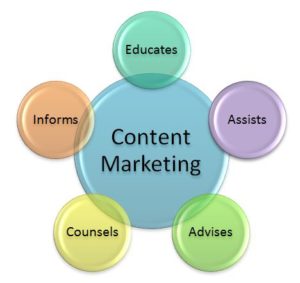Should My Business Be Doing Content Marketing?
Plus: Learn the ‘Tool Behind the Content’ Most Experts Forget to Mention
You hear about it all the time. This thing called ‘content marketing.’
You feel that pressure from the pit in your stomach when you see your “most recent” blog entry sitting there – the same one from over a year ago. On a website you haven’t updated in months.
But you also have a legitimate gripe – you tried blogging for a few months, and didn’t see any return on investment. So you lost your motivation.
The thing is – content marketing is a lot more than blogging. It has multiple forms and tools, each with different purposes.
The question isn’t if you should be doing content marketing. There are actually three questions:
- Which types of content marketing are best for your business?
- How often should you be creating it?
- How do you use your new content once it’s done?
Before we get to these, let’s agree on what content marketing is. If you do a web search, you’ll see an overly long, stuffy, intimidating definition. ProActive Content is all about simplicity. So here’s a definition of content marketing that actually makes sense:
Content marketing gives something of value to the prospect for free, whereas traditional marketing tries to make you buy. Content marketing offers. Traditional marketing asks.
Content marketing is what Dan Kennedy calls a “low-threshold” offer. It gets you in the door without asking too much of you. Traditional marketing relies on “high-threshold” offers – meaning that it requires a big first step for the consumer to take action. Not everyone is ready to call your sales team and ask about financing. If that’s your sales pitch, you’ve set a bar much higher than many potential customers are ready to climb over.
 So what is this valuable thing we’re giving away? Surely, giving free candy at your front desk isn’t content marketing (though, it’s still not a bad idea!). With content marketing, the content you give away is almost always informational. Something that educates, assists, advises, counsels, or informs. It’s something they want to know.
So what is this valuable thing we’re giving away? Surely, giving free candy at your front desk isn’t content marketing (though, it’s still not a bad idea!). With content marketing, the content you give away is almost always informational. Something that educates, assists, advises, counsels, or informs. It’s something they want to know.
The types of content you can give away help answer the first question listed above.
-
Which Types of Content Marketing Are Best for My Business?
This is a huge question. Probably the one you need to spend the most time thinking about. Here are some of your content options:
- Blog articles
- Case studies
- White papers
- Podcasts
- Videos
- Webinars
- Books – print or electronic
- CDs
- DVDs
Probably you can think of a few more. But clearly, unless you’re a larger business, you can’t start doing all of those all at once. Nor do you need to. Remember the definition of content marketing: “give away something of value.”
How do you know what’s valuable? You have to think about your customers. What kinds of problems do you solve for them? What kind content can you create that will help them solve their problems?
So, if you have a yard waste removal business, probably a podcast isn’t going to be too helpful for your customers. And a white paper is a bit too formal for leaves, gutters, trimmings, and weeds.
But a free eBook titled “5 Ways to Keep Clutter Out of Your Gutter” might be just the thing your customers are looking for. Or a DVD where you show them how to keep wasps from building nests on your eaves.
In both these examples, notice that the problem you’re solving for them isn’t directly related to your service, but it still rests within what they consider your area of expertise. One common fear of business owners about content marketing is, they think giving away their ideas will turn their customers into do-it-yourselfers, and they’ll stop buying their service.
But that’s not how it goes. The key to the content you create is to solve a problem that they care about. Anyone who is open to buying yard-debris removal isn’t going to go out and rent a truck, bag up their debris, and haul it off just because you gave them tips on how to keep their gutters clean. In fact, they’ll appreciate your tips so well that they will remember you – and you’re the one they’ll call when they have a need you can solve.
That’s really the essence of content marketing:
- Find a problem your customers deal with. A frustration, annoyance, cause of suffering, inconvenience.
- Create a tool that promises to show them how to solve that problem
- Deliver it to them using the appropriate media from the list above
- Make sure it really does solve a problem. People hate false promises and fluff. Delivering lousy content is worse than not doing it at all.
-
How Often Should I Be Creating New Content?
First, here’s a secret about having so many different types of media to choose from: You can repurpose your content in multiple forms. So, that eBook about gutters can be converted into a short series of blogs. Or, you can film a companion video showing yourself actually using your techniques. Audio can be transcribed and made into eBooks and blogs. Video testimonials can become case studies.
So, sometimes creating new content is just a matter of repurposing what you already have.
But as for how often you should make new content, this again depends on your business, and on the purpose of the content. Most content of the sort we’re talking about is meant to produce lead generation. Its goal is to attract new customers. But that’s not always the case. Your goal could be just to increase visitors to your website, which may already have effective lead capture processes in place to convert them into leads.
In a service oriented business like yard waste, you might need only a couple high-performing content pieces to win repeat customers. You can reuse the same eBook for years if it keeps performing.
But other businesses, such as an information marketer, rely heavily on a continuous flow of new content. For example, suppose you help other businesses improve their marketing and lead generation on Facebook.
Well, Facebook is constantly changing. So you’ll want to keep positioning yourself as an expert on Facebook marketing, and you’ll do this by delivering valuable content on a regular basis. That sort of business should be doing webinars and blogs at the bare minimum. But you could do much more than that.
This is why most experts talk about having a “content strategy.”
Here’s an example of a“get started” content strategy plan: Write one new blog per month, produce two eBooks per year, and have one live webinar that you’ll repurpose later as a podcast.
The point is – you create a plan, map it out, and then implement it.Don’t make a plan you can’t possibly succeed in. If you’re doing no blogging now, don’t set a plan to blog once a week. You won’t do it. If you’ve never written an eBook, don’t plan to write eight this year.
Or, if you really want that kind of output because you know the value it will bring your business, then hire an expert to produce some of it for you. As the saying goes, one can put a thousand to flight, but two can put ten thousand. Getting an expert on your team will multiply your productivity and your ROI.
-
How Do I Use My Content Once it’s Done?
This is where the ‘tool behind the content’ comes into play. Most experts don’t mention this up front because this is what scares people away from doing effective content marketing.
90% of businesses and nonprofits who create content will just put it up on their website and let it sit there to work its magic. Except, not much magic happens. This is why people often complain about blog articles not producing any ROI.
Yes, you can grow organic search traffic. And over time, consistent and quality SEO blog writing will accomplish this. But it takes a commitment.
Content marketing, as you hopefully understand now, involves much more than just blogging.
What you need to do now is use it to generate real leads. That could mean giving your eBook in exchange for contact information. Delivering CDs, DVDs, or books in exchange for home address information. Offering a recorded webinar but requiring an email address to sign up.
Whatever you do, with your most valuable content, you must get contact information from the customer in return. This could be email, phone, physical address, or all three. But once you have that, you can continue marketing to them with more content, or with follow-up phone calls. Again – your specific methods depend on your type of business.
If you want help figuring all this out, bring in a marketing consultant who understands all the layers of inbound marketing.
What’s the tool that helps you do this? It’s called a CRM – customer relationship management. There are several of these out there, such as Active Campaign and Infusionsoft. All have various pros and cons and price levels.
But this is the elephant in the room too many content marketing experts don’t talk about. Eventually, if you want a continuously improving content marketing plan, you will need a CRM. And these do cost money and take time to set up. But relax. Getting a CRM should not be your first step. I don’t even have a CRM yet, and I’m producing content.
To get started on content marketing, here’s a good plan of action:
- Determine the goal of your content marketing plan. More sales? More referrals? More visitors? More leads?
- Decide what kinds of content will help you meet this goal. Again – think about your customers!
- Make a plan for when you’ll produce this content. Stretch it out at least a few months if not a year.
- Hire someone to help produce it if you know you won’t do it yourself.
- Get writing, and get it done!
- Publish, post, or display it in the appropriate manner for that media.
- Test how it plays with your customers, and refine and improve.
- When you realize for yourself you need one – go buy a CRM.

As a final question, can you be in business in today’s world and not do content marketing? Maybe, in unique circumstances. Maybe you’ve got a very loyal and long-established customer base who will buy from you until they die. Or maybe you’re satisfied with your current income and don’t care about growing your customer base. Some businesses are in stable and comfortable positions like these.
But for most businesses these days, you have to do content marketing of some sort.
If you need help figuring what kind to start with, talk to ProActive Content today and set up a consultation.
Mention this blog article, and you can have your consultation for free!


